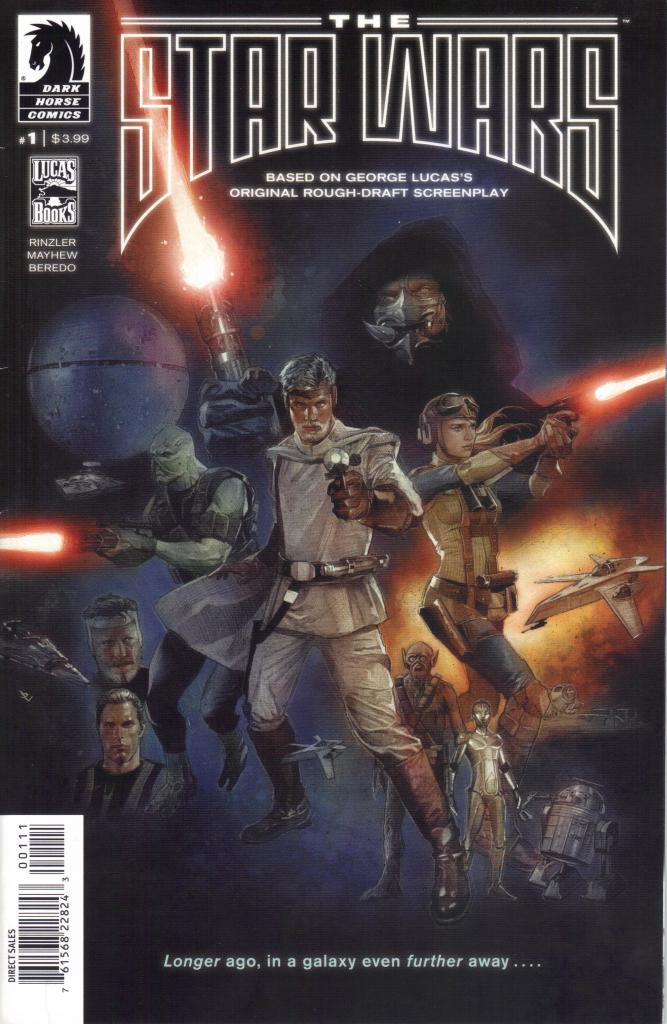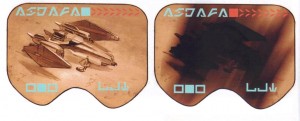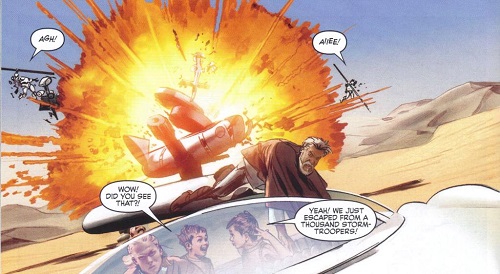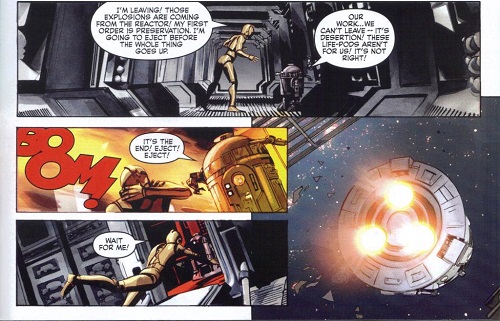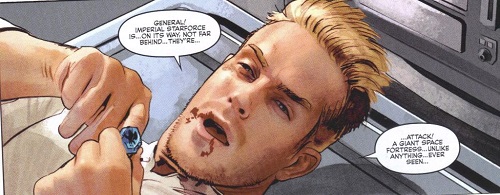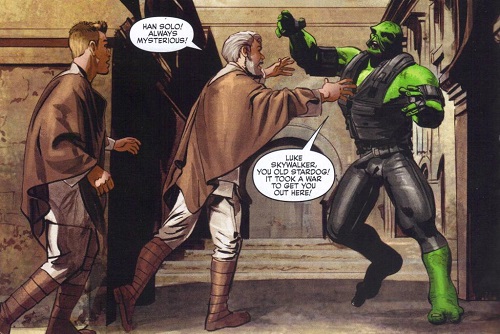Dark Horse’s eight-issue limited series The Star Wars is a fascinating exercise: a direct adaptation of the first complete draft of the screenplay that became Star Wars: A New Hope. The series is many things: a swan song for Dark Horse’s Star Wars franchise, a unique look at the creative process, and a showcase for high-caliber art that remixes Star Wars elements into a familiar yet almost disturbingly different universe.
It’s important to take note of what this story isn’t. As expressed in the letters page, Lucas’ prose has not been rewritten except to the barest minimal extent to express it on the page. So we are not dealing with high-caliber dialogue here. It’s wordy, laden with technobabble, and the love subplot makes Attack of the Clones look damn good by comparison. It’s clear that every change made along the way to the final script made it better and more filmable. But as scripter J.W. Rinzler points out in the intro and letters pages, it’s amazing to see what concepts sprang from Lucas’ pen, complete and mature, in 1974, awaiting placement in the final screenplays.
An excellent example of the similar-but-different feeling that permeates The Star Wars is the very first scene. A family, the Starkillers, is living alone on a desolate planet when they are surprised by a meteor falling through the atmosphere, much like Luke is in The Empire Strikes Back. The father, Kane, recognizes the vessel as a Sith seeker, searching for exiled Jedi-bendu like themselves. He reluctantly allows his sons, teenage Annikin and young Deak, to accompany him as he searches for the warrior. As Deak scans the ship with binoculars, a masked Sith Knight looms up in front of him, just like the Tusken Raider in A New Hope.
The child Deak is immediately slain by the Sith’s lasersword, a dark moment that calls to mind Revenge of the Sith. Kane chops the Sith in half (shades of Phantom Menace) and sets up a Return of the Jedi-style pyre for Deak. Then Kane and Annikin blast off for their home, Aquilae, where most of the action in this story takes place.
This 1974 script wears some of its influences more clearly on its sleeve, particularly Frank Herbert’s Dune and Kurosawa’s samurai movies. The Sith and the Jedi are more akin to feuding samurai clans than the embodiment of good and evil, and the Emperor is a minor character whose power play to conquer Aquilae is essentially the same as the character of the same title in Dune. But the most unique innovation of Star Wars is already present—its complete abandonment of Earth and any explicit reference to its history or mythology. This is no Flash Gordon adaptation.
Structurally, The Star Wars is most similar to The Phantom Menace. An unsuspecting planet is overrun by a vast technological empire while its defenders frantically mitigate the damage and try to catch a break. Eventually, a powerful young hero and his wise mentor harness the support of various allies and fight back, destroying the powerful space fortress and liberating the peaceful world.
Elements of this draft were ultimately used in most of the films, however. Tiny starfighters engage an impossibly large space station…twice. The heroes’ freighter dodges Imperial fighters through an asteroid field. A forest moon of furry primitives turns the tide of war just as an important villain switches sides. Meanwhile, the hero is tempted by forbidden love and two droids reveal secret weaknesses of the station. Rinzler points out on the letters page how impressive it is for a writer to be able to maintain themes and scenes after such extensive revisions.
The breathless pace of the story is as intoxicating as it is unpolished. There is nothing but plot here, with no room to sketch anything but the most basic character archetypes. The book would probably have benefitted from rewriting, but this of course would downplay the museum-piece quality, and arguably defeat the point of the whole exercise. One benefit of the screenplay that facilitates its adaptation into a comic: the action is breakneck, with multiple duels and firefights in almost every issue. It’s dazzling, and utterly, utterly unfilmable circa 1974.
The accuracy to the original screenplay is one element of geeky interest. Here’s another: the topsy-turvy feeling of same yet different, that is facilitated by the careful and creative work of artist Mike Mayhew and colorist Rain Beredo. Darth Vader is still the main villain, but he’s no Sith and wears no mask. The artists emphasize the connection with the final character by giving him the same two-tone black leather fashion sense and a scarred visage. Meanwhile, the distinctive chestplate of the movie Vader goes to Kane Starkiller, the hero’s father, who is, due to old injuries, literally more machine than man. “Luke Skywalker” is the name of this story’s older mentor character, but he retains Mark Hamill’s light hair and blue eyes. Sith Prince Valorum has a breath mask, like the movies’ Vader and many Expanded Universe Sith. Chewbacca is around, but rather than being a smuggler he’s the leader of a planet of Wookiees. The Force is mentioned only a handful of times, as a generic blessing. And C-3PO and R2-D2 are remarkably similar to their final incarnations…with the minor tweak of R2 speaking English.
The painted panels are rich with in-jokes and connections, everything from the original unused Millennium Falcon design to the bounty hunters from The Empire Strikes Back. One of the heroic rebels, Whitsun, is a dead ringer for prequel fan-editor Topher Grace. The final scene is an inspired, if cutesy, inversion of the last scene of A New Hope. Thoughtfully, the Stardestroyer fighter ships are designed as tiny versions of the wedge-shaped mile-long Star Destroyers of the film. As the series continues, Mayhew starts to simply lift designs from the films rather than using new ones inspired by the old concept art, but that’s an admittedly minor issue. In fact, it’s a pleasure to see some of those original models depicted so well.
Unfortunately, the script and series end on a weak note. Skywalker trains the Wookiees to fly Y-wing fighters in just a few hours, and they fly up and kick the ass of the Imperial space fortress, in a bizarre foreshadowing of Battlefield Earth. Meanwhile, Valorum betrays the Empire and helps Annikin escape captivity for no adequately explained reason. The excess of characters really starts to tell here, as several of them just disappear from the narrative.
Despite the great efforts of the creative team, the series never transcends being an exercise to become independently excellent. The art is certainly beautiful, but the fidelity to a fatally-flawed script holds everything back. Princess Leia is portrayed as an insufferable brat, who at one point is actually slugged unconscious and dragged from place to place—she’s basically Princess Vespa of Spaceballs. As if one royal wasn’t enough, we also have her twin little brothers, who are so superfluous to the story that they are actually put in stasis pods for several issues.
Not all flaws can be laid at the door of “perennial fan punching bag” Lucas. Everybody who’s not an alien or a robot is drawn as white and Nordic—this is especially galling given the enormous cast and the fact that nearly all of them are natives of a desert planet.
It’s also unfortunate that the “tweaked McQuarrie concept art” designs are not as unique as they should have been, since nearly every other Star Wars work including the prequel films used this approach. The idea of a parallel Star Wars universe is also gratifying, but ultimately similar to Star Wars: Legacy and Knights of the Old Republic.
Still, this series is indispensable for serious Star Wars fans and collectors. There’s no better way to experience Lucas’ early vision, since his words really need visual accompaniment. The letters pages are uniquely insightful and candid, betraying the joy that Rinzler and Mayhew felt working on this project. Even if you aren’t the biggest fan of Star Wars in particular, a lavishly produced comic book of an early draft of a screenplay doesn’t come along every day, and provides a unique glimpse of a creative process that eventually produced a pop culture juggernaut.
Keep checking Deadshirt.net throughout 2015 for more installments in our Year of Star Wars series!

